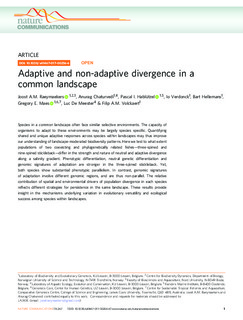| dc.contributor.author | Raeymaekers, Joost A. M. | |
| dc.contributor.author | Chaturvedi, Anurag | |
| dc.contributor.author | Hablützel, Pascal I. | |
| dc.contributor.author | Verdonck, Io | |
| dc.contributor.author | Hellemans, Bart | |
| dc.contributor.author | Maes, Gregory E. | |
| dc.contributor.author | De Meester, Luc | |
| dc.contributor.author | Volckaert, Filip A. M. | |
| dc.date.accessioned | 2017-10-27T08:50:14Z | |
| dc.date.available | 2017-10-27T08:50:14Z | |
| dc.date.created | 2017-10-12T14:36:25Z | |
| dc.date.issued | 2017 | |
| dc.identifier.issn | 2041-1723 | |
| dc.identifier.uri | http://hdl.handle.net/11250/2462516 | |
| dc.description.abstract | Species in a common landscape often face similar selective environments. The capacity of organisms to adapt to these environments may be largely species specific. Quantifying shared and unique adaptive responses across species within landscapes may thus improve our understanding of landscape-moderated biodiversity patterns. Here we test to what extent populations of two coexisting and phylogenetically related fishes—three-spined and nine-spined stickleback—differ in the strength and nature of neutral and adaptive divergence along a salinity gradient. Phenotypic differentiation, neutral genetic differentiation and genomic signatures of adaptation are stronger in the three-spined stickleback. Yet, both species show substantial phenotypic parallelism. In contrast, genomic signatures of adaptation involve different genomic regions, and are thus non-parallel. The relative contribution of spatial and environmental drivers of population divergence in each species reflects different strategies for persistence in the same landscape. These results provide insight in the mechanisms underlying variation in evolutionary versatility and ecological success among species within landscapes. | nb_NO |
| dc.language.iso | eng | nb_NO |
| dc.publisher | Nature Publishing Group | nb_NO |
| dc.rights | Navngivelse 4.0 Internasjonal | * |
| dc.rights.uri | http://creativecommons.org/licenses/by/4.0/deed.no | * |
| dc.title | Adaptive and non-adaptive divergence in a common landscape | nb_NO |
| dc.type | Journal article | nb_NO |
| dc.type | Peer reviewed | nb_NO |
| dc.description.version | publishedVersion | nb_NO |
| dc.source.volume | 8 | nb_NO |
| dc.source.journal | Nature Communications | nb_NO |
| dc.source.issue | 267 | nb_NO |
| dc.identifier.doi | 10.1038/s41467-017-00256-6 | |
| dc.identifier.cristin | 1504220 | |
| dc.relation.project | Norges forskningsråd: 223257 | nb_NO |
| dc.description.localcode | Open Access. This article is licensed under a Creative Commons Attribution 4.0 International License CC BY 4.0 (http://creativecommons.org/licenses/by/4.0/) | nb_NO |
| cristin.unitcode | 194,66,10,0 | |
| cristin.unitname | Institutt for biologi | |
| cristin.ispublished | true | |
| cristin.fulltext | original | |
| cristin.qualitycode | 2 | |

